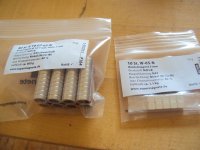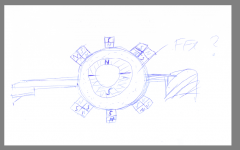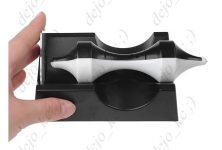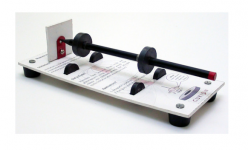Joachim,
I see from the German on the magnet package that the ring magnets are charged diametrically. So they are charged inside to out? That has always been a problem for most magnetics producers to do, is this an even charge over the entire surface? I am very interested in that process.
Steven
I see from the German on the magnet package that the ring magnets are charged diametrically. So they are charged inside to out? That has always been a problem for most magnetics producers to do, is this an even charge over the entire surface? I am very interested in that process.
Steven
Joachim I fear that you will have severe problems with the smoothness of the ride, where the magnets meet you will face stops in the motion while the magnets still float. not sure how to overcome this with repelling magnets. I have an idea to order some special shaped magnets 170 mm long, and the opposite 50 mm long, then the bearing can consist of (two) one piece guides and and the traveling sled of (two)others. Even then I fear that the big forces in the bearing will make travel impossible as even the slightest off angle will force the sled to one end. May be a thin mu-metal foil will make it possible to homogenise the neo-field and then with an adjustable chamber (parallel) it can be possible to make a magnet float linear tracker.
I am quite sure that what you have set out to do is not trivial.
I am quite sure that what you have set out to do is not trivial.
Not to discourage anyone:
Earnshaw-Theorem ? Wikipedia
The key sentence:
"Eine interessante Anwendung des Theorems ist der Nachweis der Unmöglichkeit, nur mit Dauermagneten stabil schwebende Konstruktionen zu erstellen. Für die sogenannte magnetische Levitation benötigt man deshalb entweder aktiv geregelte, dynamische Felder oder diamagnetische Materialien."
The english Wikipedia site uses different wording:
"This theorem also states that there is no possible static configuration of ferromagnets which can stably levitate an object against gravity, even when the magnetic forces are stronger than the gravitational forces."
Earnshaw's theorem has even been proven for the general case of extended bodies, and this is so even if they are flexible and conducting, provided they are not diamagnetic,[1][2] as diamagnetism constitutes a (small) repulsive force, but no attraction."
I'm not saying a LT arm can't be built based on repulsion, but there will be some mechanical contact point(s) required for operation.
Good luck!
Frank
Earnshaw-Theorem ? Wikipedia
The key sentence:
"Eine interessante Anwendung des Theorems ist der Nachweis der Unmöglichkeit, nur mit Dauermagneten stabil schwebende Konstruktionen zu erstellen. Für die sogenannte magnetische Levitation benötigt man deshalb entweder aktiv geregelte, dynamische Felder oder diamagnetische Materialien."
The english Wikipedia site uses different wording:
"This theorem also states that there is no possible static configuration of ferromagnets which can stably levitate an object against gravity, even when the magnetic forces are stronger than the gravitational forces."
Earnshaw's theorem has even been proven for the general case of extended bodies, and this is so even if they are flexible and conducting, provided they are not diamagnetic,[1][2] as diamagnetism constitutes a (small) repulsive force, but no attraction."
I'm not saying a LT arm can't be built based on repulsion, but there will be some mechanical contact point(s) required for operation.
Good luck!
Frank
I agree... I do believe that you can make a linear bearing, but there will be attraction at the ends, making the sled jammed and fixed at one position. There's no such thing as a magnetic monopole. repulsion can be used to float a platter (not too god in my opinion) or to float a radial bearing between two fixtures. but making a linear bearing without end issues is surely difficult.(probably impossible)
Joachim,
Every new thing we try always comes with some challenges. I don't think that any of these situations that I have just read are insurmountable. Yes at the junction of any two magnets you will have some stray magnetic flux but this will be minimum with direct contact of the magnetic sections. You can also remove the plating on the ends and this minimized this effect with closer contact. If the center pole piece lets call it is contained within more than one outer section at a time there may be a very minimal force changing the linear travel. Something you will have to experiment with. As far as the magnets not overcoming the force of gravity I don't see that as much of a real problem as long as these are strong magnets. Yes the travel may be a little off center but I don't think it will be far enough to cause any contact which seems to be what you are truly after, a non contact linear bearing.
Every new thing we try always comes with some challenges. I don't think that any of these situations that I have just read are insurmountable. Yes at the junction of any two magnets you will have some stray magnetic flux but this will be minimum with direct contact of the magnetic sections. You can also remove the plating on the ends and this minimized this effect with closer contact. If the center pole piece lets call it is contained within more than one outer section at a time there may be a very minimal force changing the linear travel. Something you will have to experiment with. As far as the magnets not overcoming the force of gravity I don't see that as much of a real problem as long as these are strong magnets. Yes the travel may be a little off center but I don't think it will be far enough to cause any contact which seems to be what you are truly after, a non contact linear bearing.
Last edited:
Hi Joachim,
That won't work...
The way you placed the magnets, the arm assembly will be forced forward/towards the cartridge(or backward) until it makes contact. The presence of ferrofluid will not change that.
Cheers,
Frank
P.S.: As hard as this may be to swallow, the laws of physics are, yes, insurmountable ;-)
That won't work...
The way you placed the magnets, the arm assembly will be forced forward/towards the cartridge(or backward) until it makes contact. The presence of ferrofluid will not change that.
Cheers,
Frank
P.S.: As hard as this may be to swallow, the laws of physics are, yes, insurmountable ;-)
berlinta,
I was under the assumption that the magnets were radially charged and would be within a tubular magnetic structure of opposite polarity. This would be a more practical way of making a linear bearing but what Joachim just showed makes me think of many problems with the multiple fields. If I am reading the sketch correctly the center sections are charged N/S from end to end. I don't see how that could work?
I was under the assumption that the magnets were radially charged and would be within a tubular magnetic structure of opposite polarity. This would be a more practical way of making a linear bearing but what Joachim just showed makes me think of many problems with the multiple fields. If I am reading the sketch correctly the center sections are charged N/S from end to end. I don't see how that could work?
Earnshaw's theorem has even been proven for the general case of extended bodies, and this is so even if they are flexible and conducting, provided they are not diamagnetic,[1][2] as diamagnetism constitutes a (small) repulsive force, but no attraction."
As pointed out by the quote, one can levitate diamagnetic materials such as Pyrolytic Carbon. I don't know if this has any practical significance, but it is an interesting effect. Take a look at Pyrolytic carbon - Wikipedia, the free encyclopedia
---Gary
....
Why not using an electromagnet for the inner side and a magnetring for the (outer) slide?
- Status
- This old topic is closed. If you want to reopen this topic, contact a moderator using the "Report Post" button.
- Home
- Source & Line
- Analogue Source
- The Good Turntable



